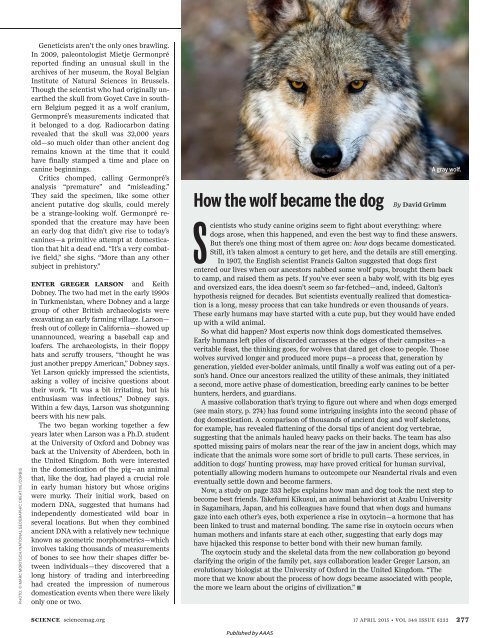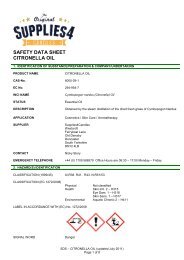Dawn-of-the-Dog
Dawn-of-the-Dog
Dawn-of-the-Dog
Create successful ePaper yourself
Turn your PDF publications into a flip-book with our unique Google optimized e-Paper software.
PHOTO: © MARC MORITSCH/NATIONAL GEOGRAPHIC CREATIVE/CORBISGeneticists aren’t <strong>the</strong> only ones brawling.In 2009, paleontologist Mietje Germonpréreported finding an unusual skull in <strong>the</strong>archives <strong>of</strong> her museum, <strong>the</strong> Royal BelgianInstitute <strong>of</strong> Natural Sciences in Brussels.Though <strong>the</strong> scientist who had originally unear<strong>the</strong>d<strong>the</strong> skull from Goyet Cave in sou<strong>the</strong>rnBelgium pegged it as a wolf cranium,Germonpré’s measurements indicated thatit belonged to a dog. Radiocarbon datingrevealed that <strong>the</strong> skull was 32,000 yearsold—so much older than o<strong>the</strong>r ancient dogremains known at <strong>the</strong> time that it couldhave finally stamped a time and place oncanine beginnings.Critics chomped, calling Germonpré’sanalysis “premature” and “misleading.”They said <strong>the</strong> specimen, like some o<strong>the</strong>rancient putative dog skulls, could merelybe a strange-looking wolf. Germonpré respondedthat <strong>the</strong> creature may have beenan early dog that didn’t give rise to today’scanines—a primitive attempt at domesticationthat hit a dead end. “It’s a very combativefield,” she sighs. “More than any o<strong>the</strong>rsubject in prehistory.”ENTER GREGER LARSON and KeithDobney. The two had met in <strong>the</strong> early 1990sin Turkmenistan, where Dobney and a largegroup <strong>of</strong> o<strong>the</strong>r British archaeologists wereexcavating an early farming village. Larson—fresh out <strong>of</strong> college in California—showed upunannounced, wearing a baseball cap andloafers. The archaeologists, in <strong>the</strong>ir floppyhats and scruffy trousers, “thought he wasjust ano<strong>the</strong>r preppy American,” Dobney says.Yet Larson quickly impressed <strong>the</strong> scientists,asking a volley <strong>of</strong> incisive questions about<strong>the</strong>ir work. “It was a bit irritating, but hisenthusiasm was infectious,” Dobney says.Within a few days, Larson was shotgunningbeers with his new pals.The two began working toge<strong>the</strong>r a fewyears later when Larson was a Ph.D. studentat <strong>the</strong> University <strong>of</strong> Oxford and Dobney wasback at <strong>the</strong> University <strong>of</strong> Aberdeen, both in<strong>the</strong> United Kingdom. Both were interestedin <strong>the</strong> domestication <strong>of</strong> <strong>the</strong> pig—an animalthat, like <strong>the</strong> dog, had played a crucial rolein early human history but whose originswere murky. Their initial work, based onmodern DNA, suggested that humans hadindependently domesticated wild boar inseveral locations. But when <strong>the</strong>y combinedancient DNA with a relatively new techniqueknown as geometric morphometrics—whichinvolves taking thousands <strong>of</strong> measurements<strong>of</strong> bones to see how <strong>the</strong>ir shapes differ betweenindividuals—<strong>the</strong>y discovered that along history <strong>of</strong> trading and interbreedinghad created <strong>the</strong> impression <strong>of</strong> numerousdomestication events when <strong>the</strong>re were likelyonly one or two.How <strong>the</strong> wolf became <strong>the</strong> dog By David GrimmA gray wolf.Scientists who study canine origins seem to fight about everything: wheredogs arose, when this happened, and even <strong>the</strong> best way to find <strong>the</strong>se answers.But <strong>the</strong>re’s one thing most <strong>of</strong> <strong>the</strong>m agree on: how dogs became domesticated.Still, it’s taken almost a century to get here, and <strong>the</strong> details are still emerging.In 1907, <strong>the</strong> English scientist Francis Galton suggested that dogs firstentered our lives when our ancestors nabbed some wolf pups, brought <strong>the</strong>m backto camp, and raised <strong>the</strong>m as pets. If you’ve ever seen a baby wolf, with its big eyesand oversized ears, <strong>the</strong> idea doesn’t seem so far-fetched—and, indeed, Galton’shypo<strong>the</strong>sis reigned for decades. But scientists eventually realized that domesticationis a long, messy process that can take hundreds or even thousands <strong>of</strong> years.These early humans may have started with a cute pup, but <strong>the</strong>y would have endedup with a wild animal.So what did happen? Most experts now think dogs domesticated <strong>the</strong>mselves.Early humans left piles <strong>of</strong> discarded carcasses at <strong>the</strong> edges <strong>of</strong> <strong>the</strong>ir campsites—averitable feast, <strong>the</strong> thinking goes, for wolves that dared get close to people. Thosewolves survived longer and produced more pups—a process that, generation bygeneration, yielded ever-bolder animals, until finally a wolf was eating out <strong>of</strong> a person’shand. Once our ancestors realized <strong>the</strong> utility <strong>of</strong> <strong>the</strong>se animals, <strong>the</strong>y initiateda second, more active phase <strong>of</strong> domestication, breeding early canines to be betterhunters, herders, and guardians.A massive collaboration that’s trying to figure out where and when dogs emerged(see main story, p. 274) has found some intriguing insights into <strong>the</strong> second phase <strong>of</strong>dog domestication. A comparison <strong>of</strong> thousands <strong>of</strong> ancient dog and wolf skeletons,for example, has revealed flattening <strong>of</strong> <strong>the</strong> dorsal tips <strong>of</strong> ancient dog vertebrae,suggesting that <strong>the</strong> animals hauled heavy packs on <strong>the</strong>ir backs. The team has alsospotted missing pairs <strong>of</strong> molars near <strong>the</strong> rear <strong>of</strong> <strong>the</strong> jaw in ancient dogs, which mayindicate that <strong>the</strong> animals wore some sort <strong>of</strong> bridle to pull carts. These services, inaddition to dogs’ hunting prowess, may have proved critical for human survival,potentially allowing modern humans to outcompete our Neandertal rivals and eveneventually settle down and become farmers.Now, a study on page 333 helps explains how man and dog took <strong>the</strong> next step tobecome best friends. Takefumi Kikusui, an animal behaviorist at Azabu Universityin Sagamihara, Japan, and his colleagues have found that when dogs and humansgaze into each o<strong>the</strong>r’s eyes, both experience a rise in oxytocin—a hormone that hasbeen linked to trust and maternal bonding. The same rise in oxytocin occurs whenhuman mo<strong>the</strong>rs and infants stare at each o<strong>the</strong>r, suggesting that early dogs mayhave hijacked this response to better bond with <strong>the</strong>ir new human family.The oxytocin study and <strong>the</strong> skeletal data from <strong>the</strong> new collaboration go beyondclarifying <strong>the</strong> origin <strong>of</strong> <strong>the</strong> family pet, says collaboration leader Greger Larson, anevolutionary biologist at <strong>the</strong> University <strong>of</strong> Oxford in <strong>the</strong> United Kingdom. “Themore that we know about <strong>the</strong> process <strong>of</strong> how dogs became associated with people,<strong>the</strong> more we learn about <strong>the</strong> origins <strong>of</strong> civilization.” ■SCIENCE sciencemag.orgPublished by AAAS17 APRIL 2015 • VOL 348 ISSUE 6232 277



